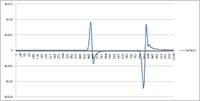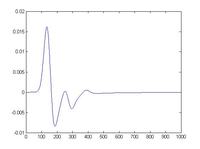varunag
Newbie level 3
Re: [trouble]2D fdtd : wave shape distorted after propagatio
Hi all,
I am doing a project on FDTD simulation. I have used Taflove book as the reference. The code is implemented in Fortran90.
I am simulating TMz mode and exciting the Ez with a gaussian pulse at the center of the whole 2D space.
As Ez propagates in the plane, the gaussian wave is distorted.
This is what I did:
the 2D space is (500,500).
Ez(250,250) is excited.
The boundaries are PEC(Ez=0).
I observed Ez(100,100). And this is what I get. Why do I get a negative peak? Can you explain me the reason for this?

I suppose the above information is sufficient to understand my problem, but if you need any more specifics let me know.
Added after 1 hours 39 minutes:
I was trying the 2D code which is written in MATLAB and is available with the book. The result I obtained is similar. Can someone tell me why do we get such a result, instead of a gaussian pulse???

Hi all,
I am doing a project on FDTD simulation. I have used Taflove book as the reference. The code is implemented in Fortran90.
I am simulating TMz mode and exciting the Ez with a gaussian pulse at the center of the whole 2D space.
As Ez propagates in the plane, the gaussian wave is distorted.
This is what I did:
the 2D space is (500,500).
Ez(250,250) is excited.
The boundaries are PEC(Ez=0).
I observed Ez(100,100). And this is what I get. Why do I get a negative peak? Can you explain me the reason for this?

I suppose the above information is sufficient to understand my problem, but if you need any more specifics let me know.
Added after 1 hours 39 minutes:
I was trying the 2D code which is written in MATLAB and is available with the book. The result I obtained is similar. Can someone tell me why do we get such a result, instead of a gaussian pulse???
